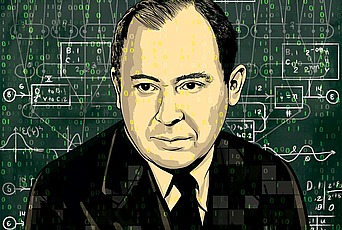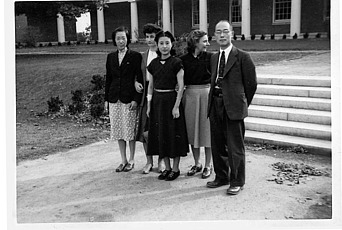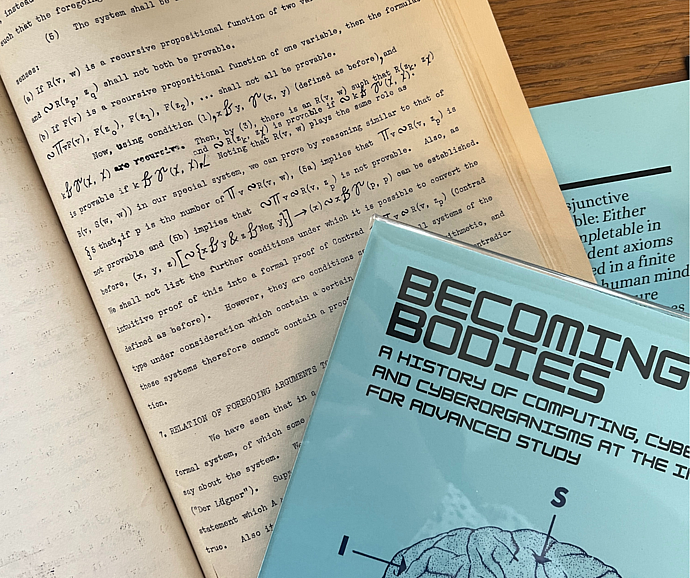
“Becoming Bodies” Exhibition Explores the History of Computing, Cybernetics, and Cyberorganisms
The rising prominence of artificial intelligence continues to blur the lines between human and machine. With this in mind, an exhibition currently displayed in the Shelby White and Leon Levy Archives Center and the Mathematics - Natural Sciences Library reveals that, since its founding, the Institute has been a key space for the testing and contesting of these boundaries. The archival materials also show that IAS scholars, from John von Neumann to Wendy Hui Kyong Chun, have demonstrated a sustained interest in not only the theoretical work of computing but also the wider societal implications of the advancing technology.
The exhibition highlights how the Institute played a significant role in the history of computing. It begins with the work of Alan Turing, specifically his seminal paper “On Computable Numbers,” which was published during his time at Princeton University. The paper, which builds on IAS Faculty Kurt Gödel’s contemporaneous “Incompleteness” Theorems, is an example of a highly “productive” negative result. Turing proved yet again, following the work of Alonzo Church (IAS Member in the School of Mathematics, 1934–35), that there is no one all-powerful algorithm that can determine whether any given mathematical yes-or-no question is provable. With the methods of these proofs, Turing invented the theoretical basis of computer science, with his so-called “Turing machine,” an imagined computing device that would (hypothetically) perform computations by reading and writing to an infinite tape.
The practical realization of the theoretical concepts introduced by the Turing machine came in the form of founding Faculty John von Neumann’s Electronic Computer Project (ECP), active at the Institute from 1945–57. Although von Neumann himself considered Turing's work separate from his own, the ECP’s creation of one of the first stored-program computers, where instructions and data were stored in the same memory, is often linked to Turing’s ideas. So many IAS scholars from von Neumann’s day to the present have sought inspiration from Turing’s publication that their interest is physically visible in the frayed bindings of the Institute’s print edition of the journal, on display in the exhibition.
Another aspect of interest in Turing’s paper is the evolving use of the word “computer.” Turing initially uses “computer” to refer to a living, human person who computes figures. But by the end, “computer” is used to refer to a machine. This highlights how, in the 1930s, scholars found themselves on the precipice of a major shift not only in technology but in language. This feeds into another question explored by the exhibition, one of a more emotional nature: why might people not feel entirely comfortable with humans coming to be described in computer terms, and vice versa?
The exhibition also outlines early resistance to computers as a whole, both at the Institute and in wider society. Archival documents which speak to this issue include a scathing letter written in 1946 by Benjamin Meritt, a Professor in the School of Historical Studies. In the missive, addressed to then-Director Frank Aydelotte, Meritt expressed his chagrin at having returned from a trip abroad to find that his basement had been taken over by the Electronic Computer Project, which at that time was waiting for its dedicated building on the Institute campus to be completed. Meritt deemed the ECP of little value and a waste of space! This document is accompanied in the exhibition by a reprint of a New York Times article from 1972 which outlines fears about computing technology, drawing from a three-day symposium held at the Institute in honor of von Neumann. Carl Kaysen, the then-Director, and Kurt Gödel were among the participants. The article presents man and computer as being in an “uneasy” alliance. Computers were also alleged to “threaten the primacy of man.”

The displays move on to show how IAS scholars from all Schools began to engage thoughtfully with computing technology. One example is a profile of research by Patrick Geary, Professor Emeritus in the School of Historical Studies, on the subject of paleogenetics. It also delves into the interdisciplinarity of research into cybernetics, a field with which scholars working at the Institute were closely engaged.
In short, cybernetics can be described as the study of “human-computer interaction.” “Cybernetics” as a term was first coined in 1948 by American computer scientist and mathematician Norbert Wiener. The word itself is a neologism taken from the Greek κυβερνήτης (kybernētēs, meaning steersman or governor). Wiener used the term to articulate the creation of a new discipline intended to study the “science of control and communications in the animal and machine,” which encompassed mathematical logic, statistics, information theory, neurology, and information theory, among other disciplines.
Cybernetics feeds into the exhibition through the papers of Julian Bigelow, who worked on the Electronic Computing Project as an engineer and went on to become a Member in both the Schools of Mathematics and Natural Sciences. The proceedings of the Second Annual Conference on the Cyber-Cultural Revolution, held in 1965, are preserved among his papers. The proceedings demonstrate how interdisciplinarity became the calling card of cybernetics research. At the conference, panels included discussion around technology and learning processes, the potential impact of technological and computational advances on work and labor, and man’s use of men and machines, topics which seem intimately familiar to those who are engaged in debates surrounding artificial intelligence today.
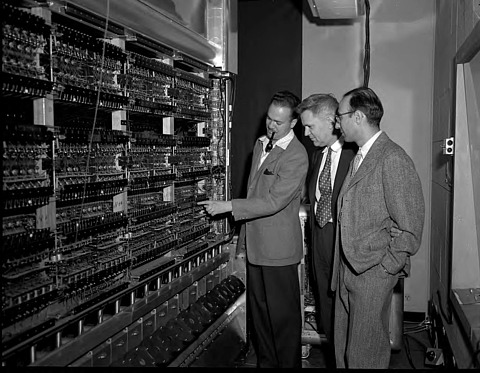
Indeed, the exhibition was partially inspired by the work of Alondra Nelson, Harold F. Linder Professor in the School of Social Science, which explores the regulation and impact of AI in the contemporary moment, and the related PLATFORM theme year currently taking place in the School. The exhibition’s curators were keen to investigate when, where, and how the questions that are being asked today in the School have arisen before at IAS. In addition to Bigelow’s papers, another historical precedent to the PLATFORM year comes in the form of the work of Donna Haraway, Member (1978–88) in the School of Social Science. The exhibition features Haraway’s proposal for the project she would work on at IAS, titled Bodily Technologies and Systems Difference. It touches on themes of social justice and the way automation and computation might replace and re-envision the human body.
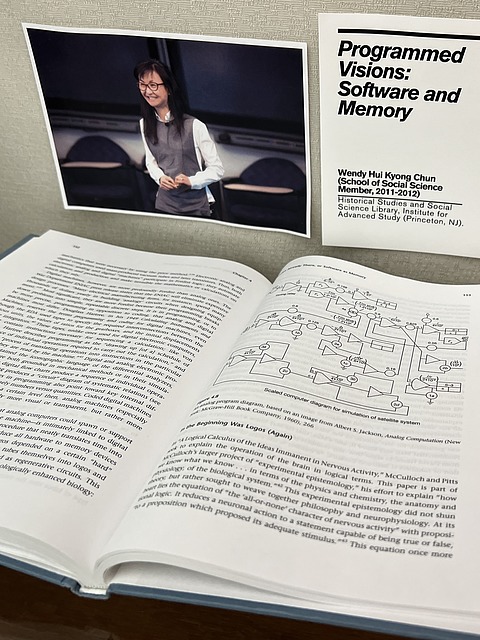
Following from this, another key document that brings the exhibition fully into the current moment is the work of Wendy Hui Kyong Chun, Member (2011–12) in the School of Social Science. Chun’s book Programmed Visions: Software and Memory is displayed as a counterpoint to the cohort featured in Bigelow’s papers by telling a story about the history of exclusion. In the book, Chun discusses the visibility and invisibility of race in the history of computing. Her work makes the point that although there are people of color in this story, their work tends not to have a theoretical focus. As a result, they are often unrepresented in the history of the discipline.
“Becoming Bodies: The History of Computing, Cybernetics, and Cyberorganisms at the Institute for Advanced Study” is on display in the Shelby White and Leon Levy Archives Center and the Mathematics-Natural Sciences Library in Fuld Hall until late April 2024. The exhibition is open to all members of the Institute community. Members of the public are also welcome. Please contact the Shelby White and Leon Levy Archives Center to arrange a visit.
